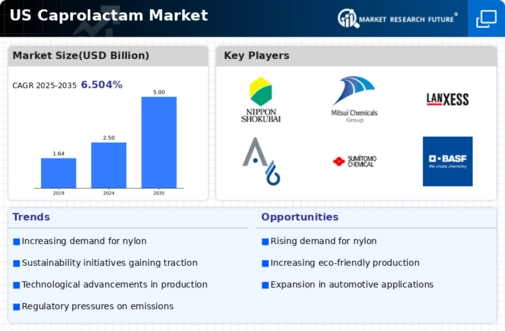The caprolactam market exhibits a dynamic competitive landscape characterized by a blend of established players and emerging innovators. Key growth drivers include the increasing demand for nylon 6 in various applications, particularly in automotive and textiles, alongside a growing emphasis on sustainability. Major companies such as BASF SE (Germany), AdvanSix Inc (US), and China National Chemical Corporation (China) are strategically positioned to leverage these trends. BASF SE (Germany) focuses on innovation and sustainability, investing in advanced production technologies to enhance efficiency and reduce environmental impact. AdvanSix Inc (US) emphasizes local manufacturing and supply chain optimization, aiming to strengthen its market presence in North America. Meanwhile, China National Chemical Corporation (China) is expanding its global footprint through strategic partnerships and acquisitions, thereby intensifying competition in the market.
The business tactics employed by these companies reflect a moderately fragmented market structure, where localized manufacturing and supply chain optimization play crucial roles. The collective influence of these key players shapes the competitive environment, as they strive to enhance operational efficiencies and respond to evolving customer demands. This competitive structure fosters innovation and drives companies to adopt advanced technologies, thereby enhancing their market positions.
In September 2025, BASF SE (Germany) announced the launch of a new caprolactam production facility in the US, aimed at increasing its production capacity by 20%. This strategic move is significant as it not only enhances BASF's ability to meet rising demand but also underscores its commitment to sustainability through the implementation of energy-efficient technologies. Such initiatives are likely to bolster BASF's competitive edge in the market.
In August 2025, AdvanSix Inc (US) entered into a strategic partnership with a leading automotive manufacturer to supply caprolactam for high-performance nylon applications. This collaboration is pivotal as it aligns with the growing trend of lightweight materials in the automotive sector, potentially increasing AdvanSix's market share and reinforcing its position as a key supplier in the industry. The partnership reflects a proactive approach to capitalize on emerging market opportunities.
In October 2025, China National Chemical Corporation (China) completed the acquisition of a regional caprolactam producer, enhancing its production capabilities and market reach in North America. This acquisition is indicative of a broader trend towards consolidation in the industry, allowing China National Chemical Corporation to leverage synergies and optimize its supply chain. Such strategic actions are likely to reshape the competitive landscape, as companies seek to enhance their operational efficiencies and market presence.
As of November 2025, current competitive trends in the caprolactam market are increasingly defined by digitalization, sustainability, and the integration of advanced technologies such as AI. Strategic alliances are becoming more prevalent, enabling companies to pool resources and expertise to drive innovation. The competitive differentiation is expected to evolve, shifting from traditional price-based competition to a focus on innovation, technology, and supply chain reliability. This transition may redefine market dynamics, compelling companies to adapt and innovate continuously to maintain their competitive positions.


























Leave a Comment